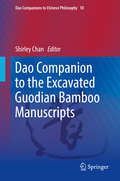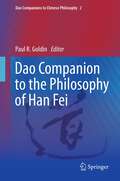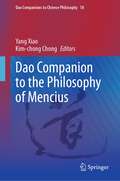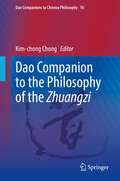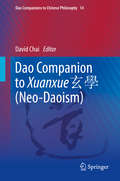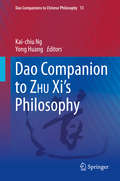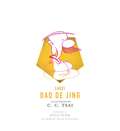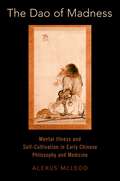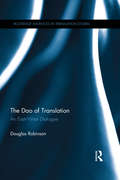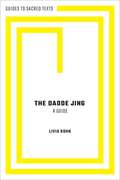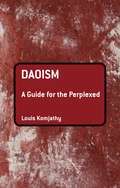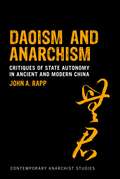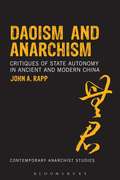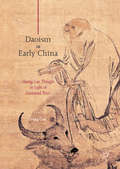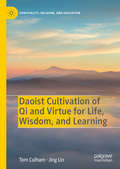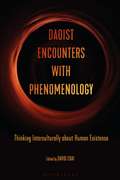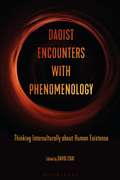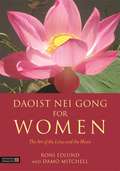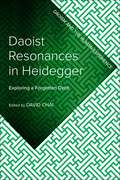- Table View
- List View
Dao Companion to the Excavated Guodian Bamboo Manuscripts (Dao Companions to Chinese Philosophy #10)
by Shirley ChanThis volume covers the philosophical, historical, religious, and interpretative aspects of the ancient Guodian bamboo manuscripts (郭店楚簡) which were disentombed in the Guodian Village in Hubei Province, China, in 1993. Considered to be the Chinese equivalent of the Dead Sea Scrolls, these manuscripts are archaeological finds whose importance cannot be underestimated. Many of the texts are without counterparts in the transmitted tradition, and they provide unique insights into the developments of Chinese philosophy in the period between the death of Confucius (551-479 BCE) and the writings of Mencius (c.372-289 BCE), and beyond. Divided into two parts, the book first provides inter-textual contexts and backgrounds of the Guodian manuscripts. The second part covers the main concepts and arguments in the Guodian texts, including cosmology and metaphysics, political philosophy, moral psychology, and theory of human nature. The thematic essays serve as an introduction to the philosophical significance and the key philosophical concepts/thought of each text contained in the Guodian corpus. Each chapter has a section on the implications of the texts for the received tradition, or for the purpose of comparing some of the text(s) with the received tradition in terms of the key philosophical concepts as well as the reading and interpretation of the texts. The volume covers most of the texts inscribed on the 800-odd slips of the Guodian corpus dated to the fourth century BCE.
Dao Companion to the Philosophy of Han Fei (Dao Companions to Chinese Philosophy)
by Paul R. GoldinHan Fei, who died in 233 BC, was one of the primary philosophers of China’s classical era, a reputation still intact despite recent neglect. This edited volume on the thinker, his views on politics and philosophy, and the tensions of his relations with Confucianism (which he derided) is the first of its kind in English.Featuring contributions from specialists in various disciplines including religious studies and literature, this new addition to the Dao Companions to Chinese Philosophy series includes the latest research. It breaks new ground with studies of Han Fei’s intellectual antecedents, and his relationship as a historical figure with Han Feizi, the text attributed to him, as well as surveying the full panoply of his thought. It also includes a chapter length survey of relevant scholarship, both in Chinese and Japanese.
Dao Companion to the Philosophy of Mencius (Dao Companions to Chinese Philosophy #18)
by Yang Xiao Kim-Chong ChongThis book is about the philosophical, historical, and interpretative aspects of Mencius. It explores his influence, reception, and relevance in China from the third century BCE to the present, as well as offers comparative studies of Mencius and major figures in the history of Chinese and Western philosophy. With 34 accessible articles written by leading philosophers and scholars, the Dao Companion to the Philosophy of Mencius provides both broad pictures and in-depth discussions regarding the work of one of the most important and influential Chinese philosophers. It covers his normative ethics, meta-ethics, political philosophy, epistemology and moral psychology. The last section of the volume, “Mencius and Western Philosophers: Comparative Perspectives,” explicitly puts him in dialogue with major Western philosophers. The Dao Companion to the Philosophy of Mencius serves as an essential volume for college students, graduate students, and scholars who study and teach Mencius as well as Chinese philosophy and comparative philosophy in general.
Dao Companion to the Philosophy of the Zhuangzi (Dao Companions to Chinese Philosophy #16)
by Kim-Chong ChongThis comprehensive collection brings out the rich and deep philosophical resources of the Zhuangzi. It covers textual, linguistic, hermeneutical, ethical, social/political and philosophical issues, with the latter including epistemological, metaphysical, phenomenological and cross-cultural (Chinese and Western) aspects. The volume starts out with the textual history of the Zhuangzi, and then examines how language is used in the text. It explores this unique characteristic of the Zhuangzi, in terms of its metaphorical forms, its use of humour in deriding and parodying the Confucians, and paradoxically making Confucius the spokesman for Zhuangzi’s own point of view. The volume discusses questions such as: Why does Zhuangzi use language in this way, and how does it work? Why does he not use straightforward propositional language? Why is language said to be inadequate to capture the “dao” and what is the nature of this dao? The volume puts Zhuangzi in the philosophical context of his times, and discusses how he relates to other philosophers such as Laozi, Xunzi, and the Logicians.
Dao Companion to Xuanxue 玄學 (Dao Companions to Chinese Philosophy #14)
by David ChaiThis comprehensive volume surveys an important but neglected period of Chinese intellectual history: Xuanxue (Neo-Daoism). It provides a holistic approach to the philosophical and religious traits of this movement via the concepts of non-being, being, and oneness. Thinkers and texts on the periphery of Xuanxue are also examined to show readers that Xuanxue did not arise in a vacuum but is the result of a long and continuous evolution of ideas from pre-Qin Daoism. The 25 chapters of this work survey the major philosophical figures and arguments of Xuanxue, a movement from the Wei-Jin dynastic period (220-420 CE) of early-medieval China. It also examines texts and figures from the late-Han dynasty whose influence on Xuanxue has yet to be made explicitly clear. In order to fully capture the multifaceted nature of this movement, the contributors brilliantly highlight its more socially-oriented characteristics. Overall, this volume presents an unrivaled picture of this exciting period. It details a portrait of intellectual and cultural vitality that rivals, if not surpasses, what was achieved during the Warring States period. Readers of the Yijing, Daodejing, and Zhuangzi will feel right at home with the themes and arguments presented herein, while students and those coming to Xuanxue for the first time will acquire a wealth of knowledge.
Dao Companion to ZHU Xi’s Philosophy (Dao Companions to Chinese Philosophy #13)
by Yong Huang Kai-Chiu NgZhu Xi (1130-1200) has been commonly and justifiably recognized as the most influential philosopher of Neo-Confucianism, a revival of classical Confucianism in face of the challenges coming from Daoism and, more importantly, Buddhism. His place in the Confucian tradition is often and also very plausibly compared to that of Thomas Aquinas, slightly later, in the Christian tradition. This book presents the most comprehensive and updated study of this great philosopher. It situates Zhu Xi’s philosophy in the historical context of not only Confucian philosophy but also Chinese philosophy as a whole. Topics covered within Zhu Xi’s thought are metaphysics, epistemology, ethics, political philosophy, hermeneutics, philosophy of religion, moral psychology, and moral education. This text shows both how Zhu Xi responded to earlier thinkers and how his thoughts resonate in contemporary philosophy, particularly in the analytic tradition. This companion will appeal to students, researchers and educators in the field.
Dao De Jing (The Illustrated Library of Chinese Classics #27)
by Laozi C. C. TsaiFrom bestselling cartoonist C. C. Tsai, a delightfully illustrated version of the classic work of Daoist philosophyC. C. Tsai is one of Asia's most popular cartoonists, and his editions of the Chinese classics have sold more than 40 million copies in over twenty languages. Here, he works his magic again with a delightful graphic adaptation of the complete text of Laozi's Dao De Jing, the beloved source of Daoist philosophy. Masterfully transforming Laozi's challenging work into entertaining and enlightening episodes, Tsai offers a uniquely fresh, relevant, and accessible version of one of the world's most influential books.After opening with Laozi's biography from the Shi Ji, Tsai turns the stage over to Laozi, who patiently explains his ideas to his earnest students (and us). Laozi describes the spontaneity of natural processes, the paradoxical effects of ethical precepts, the limits of language, the values of simplicity, and, above all else, how to go with the flow. In brief episodes that tantalize and inspire, he takes us into the subtle complexities of human existence. Ultimately, Laozi, a master visionary, guides us to the mountaintop to reveal an expansive view of life.A marvelous edition of a timeless classic, this book also presents Laozi's original Chinese text in sidebars on each page, enriching the book for readers and students of Chinese without distracting from the English-language cartoons. The text is skillfully translated by Brian Bruya, who also provides an illuminating introduction.
The Dao of Madness: Mental Illness and Self-Cultivation in Early Chinese Philosophy and Medicine
by Alexus McLeodMental illness complicates views of agency and moral responsibility in ethics. Particularly for traditions and theories focused on self-cultivation, such as Aristotelian virtue ethics and many systems of ethics in early Chinese philosophy, mental illness offers powerful challenges. Can the mentally ill person cultivate herself and achieve a level of virtue, character, or thriving similar to the mentally healthy? Does mental illness result from failures in self-cultivation, failure in social institutions or rulership, or other features of human activity? Can a life complicated by struggles with mental illness be a good one? The Dao of Madness investigates the role of mental illness, specifically "madness" (kuang), in discussions of self-cultivation and ideal personhood in early Chinese philosophical and medical thought, and the ways in which early Chinese thinkers probed difficult questions surrounding mental health. Alexus McLeod explores three central accounts: the early "traditional" views of those, including Confucians, taking madness to be the result of character flaw; the challenge from Zhuangists celebrating madness as a freedom from standard norms connected to knowledge; and the "medicalization" of madness within the naturalistic shift of Han Dynasty thought. Understanding views on madness in the ancient world helps reveal key features of Chinese thinkers' conceptions of personhood and agency, as well as their accounts of ideal activity. Further, it exposes the motivations behind the origins of the medical tradition, and of the key links between philosophy and medicine in early Chinese thought. The early Chinese medical tradition has crucial and understudied connections to early philosophy, connections which this volume works to uncover.
The Dao of Madness: Mental Illness and Self-Cultivation in Early Chinese Philosophy and Medicine
by Alexus McLeodMental illness complicates views of agency and moral responsibility in ethics. Particularly for traditions and theories focused on self-cultivation, such as Aristotelian virtue ethics and many systems of ethics in early Chinese philosophy, mental illness offers powerful challenges. Can the mentally ill person cultivate herself and achieve a level of virtue, character, or thriving similar to the mentally healthy? Does mental illness result from failures in self-cultivation, failure in social institutions or rulership, or other features of human activity? Can a life complicated by struggles with mental illness be a good one? The Dao of Madness investigates the role of mental illness, specifically "madness" (kuang), in discussions of self-cultivation and ideal personhood in early Chinese philosophical and medical thought, and the ways in which early Chinese thinkers probed difficult questions surrounding mental health. Alexus McLeod explores three central accounts: the early "traditional" views of those, including Confucians, taking madness to be the result of character flaw; the challenge from Zhuangists celebrating madness as a freedom from standard norms connected to knowledge; and the "medicalization" of madness within the naturalistic shift of Han Dynasty thought. Understanding views on madness in the ancient world helps reveal key features of Chinese thinkers' conceptions of personhood and agency, as well as their accounts of ideal activity. Further, it exposes the motivations behind the origins of the medical tradition, and of the key links between philosophy and medicine in early Chinese thought. The early Chinese medical tradition has crucial and understudied connections to early philosophy, connections which this volume works to uncover.
The Dao of Translation: An East-West Dialogue (Routledge Advances in Translation and Interpreting Studies)
by Douglas RobinsonThe Dao of Translation sets up an East-West dialogue on the nature of language and translation, and specifically on the "unknown forces" that shape the act of translation. To that end it mobilizes two radically different readings of the Daodejing (formerly romanized as the Tao Te Ching): the traditional "mystical" reading according to which the Dao is a mysterious force that cannot be known, and a more recent reading put forward by Sinologists Roger T. Ames and David L. Hall, to the effect that the Dao is simply the way things happen. Key to Ames and Hall’s reading is that what makes the Dao seem both powerful and mysterious is that it channels habit into action—or what the author calls social ecologies, or icoses. The author puts Daoism (and ancient Confucianism) into dialogue with nineteenth-century Western theorists of the sign, Charles Sanders Peirce and Ferdinand de Saussure (and their followers), in order to develop an "icotic" understanding of the tensions between habit and surprise in the activity of translating. The Dao of Translation will interest linguists and translation scholars. This book will also engage researchers of ancient Chinese philosophy and provide Western scholars with a thought-provoking cross-examination of Eastern and Western perspectives.
The Dao of Translation: An East-West Dialogue (Routledge Advances in Translation and Interpreting Studies)
by Douglas RobinsonThe Dao of Translation sets up an East-West dialogue on the nature of language and translation, and specifically on the "unknown forces" that shape the act of translation. To that end it mobilizes two radically different readings of the Daodejing (formerly romanized as the Tao Te Ching): the traditional "mystical" reading according to which the Dao is a mysterious force that cannot be known, and a more recent reading put forward by Sinologists Roger T. Ames and David L. Hall, to the effect that the Dao is simply the way things happen. Key to Ames and Hall’s reading is that what makes the Dao seem both powerful and mysterious is that it channels habit into action—or what the author calls social ecologies, or icoses. The author puts Daoism (and ancient Confucianism) into dialogue with nineteenth-century Western theorists of the sign, Charles Sanders Peirce and Ferdinand de Saussure (and their followers), in order to develop an "icotic" understanding of the tensions between habit and surprise in the activity of translating. The Dao of Translation will interest linguists and translation scholars. This book will also engage researchers of ancient Chinese philosophy and provide Western scholars with a thought-provoking cross-examination of Eastern and Western perspectives.
The Daode Jing: A Guide (Guides to Sacred Texts)
by Livia KohnThe Daode jing ("Book of the Dao and Its Virtue") is an essential work in both traditional Chinese culture and world philosophy. The oldest text of philosophical Daoism, and widely venerated among religious Daoist practitioners, it was composed around the middle of the 4th century BCE. Ascribed to a thinker named Laozi, a contemporary of Confucius, the work is based on a set of aphorisms designed to help local lords improve their techniques of government. The most translated book after the Bible, the Daode jing appears in numerous variants and remains highly relevant in the modern world. This guide provides an overview of the text, presenting its historical unfolding, its major concepts, and its contemporary use. It also gives some indication of its essence by citing relevant passages and linking them to the religious practices of traditional Daoism.
DAODE JING: A Guide (Guides to Sacred Texts)
by Livia KohnThe Daode jing ("Book of the Dao and Its Virtue") is an essential work in both traditional Chinese culture and world philosophy. The oldest text of philosophical Daoism, and widely venerated among religious Daoist practitioners, it was composed around the middle of the 4th century BCE. Ascribed to a thinker named Laozi, a contemporary of Confucius, the work is based on a set of aphorisms designed to help local lords improve their techniques of government. The most translated book after the Bible, the Daode jing appears in numerous variants and remains highly relevant in the modern world. This guide provides an overview of the text, presenting its historical unfolding, its major concepts, and its contemporary use. It also gives some indication of its essence by citing relevant passages and linking them to the religious practices of traditional Daoism.
Daoism: A Guide for the Perplexed (Guides for the Perplexed)
by Louis KomjathyDaoism is a global religious and cultural phenomenon characterized by multiculturalism and ethnic diversity. Daoism: A Guide for the Perplexed offers a clear and thorough survey of this ancient and modern religious tradition. The book includes an overview of Daoist history, including key individuals and movements, translations of primary Daoist texts, and discussions of key dimensions of Daoist religiosity, covering primary concerns and defining characteristics of the religion.Specifically designed to meet the needs of students and general readers seeking a thorough understanding of the religion, this book is the ideal guide to studying and understanding Daoism as a lived and living religious community.
Daoism: Mysticism And Self-transformation In Early Quanzhen Daoism (Guides for the Perplexed #311)
by Louis KomjathyDaoism is a global religious and cultural phenomenon characterized by multiculturalism and ethnic diversity. Daoism: A Guide for the Perplexed offers a clear and thorough survey of this ancient and modern religious tradition. The book includes an overview of Daoist history, including key individuals and movements, translations of primary Daoist texts, and discussions of key dimensions of Daoist religiosity, covering primary concerns and defining characteristics of the religion.Specifically designed to meet the needs of students and general readers seeking a thorough understanding of the religion, this book is the ideal guide to studying and understanding Daoism as a lived and living religious community.
Daoism and Anarchism: Critiques of State Autonomy in Ancient and Modern China (Contemporary Anarchist Studies)
by John A. RappThis volume in the Contemporary Anarchist Studies series focuses on anti-statist critiques in ancient and modern China and demonstrates that China does not have an unchallenged authoritarian political culture.Treating anarchism as a critique of centralized state power, the work first examines radical Daoist thought from the 4th century BCE to the 9th century CE and compares Daoist philosophers and poets to Western anarchist and utopian thinkers. This is followed by a survey of anarchist themes in dissident thought in the People's Republic of China from 1949 to the present. A concluding chapter discusses how Daoist anarchism can be applied to any anarchist-inspired radical critique today. This work not only challenges the usual ideas of the scope and nature of dissent in China, it also provides a unique comparison of ancient Chinese Daoist anarchism to Western anarchist. Featuring previously untranslated texts, such as the 9th century Buddhist anarchist tract, the Wunengzi, and essays from the PRC press, it will be an essential resource to anyone studying anarchism, Chinese political thought, political dissent, and political history.
Daoism and Anarchism: Critiques of State Autonomy in Ancient and Modern China (Contemporary Anarchist Studies)
by John A. RappThis volume in the Contemporary Anarchist Studies series focuses on anti-statist critiques in ancient and modern China and demonstrates that China does not have an unchallenged authoritarian political culture.Treating anarchism as a critique of centralized state power, the work first examines radical Daoist thought from the 4th century BCE to the 9th century CE and compares Daoist philosophers and poets to Western anarchist and utopian thinkers. This is followed by a survey of anarchist themes in dissident thought in the People's Republic of China from 1949 to the present. A concluding chapter discusses how Daoist anarchism can be applied to any anarchist-inspired radical critique today. This work not only challenges the usual ideas of the scope and nature of dissent in China, it also provides a unique comparison of ancient Chinese Daoist anarchism to Western anarchist. Featuring previously untranslated texts, such as the 9th century Buddhist anarchist tract, the Wunengzi, and essays from the PRC press, it will be an essential resource to anyone studying anarchism, Chinese political thought, political dissent, and political history.
Daoism in Early China: Huang-Lao Thought in Light of Excavated Texts
by Feng CaoThis text considers the prevalence of Lao-Zhuang Daoism and Huang-Lao Daoism in late pre-imperial and early imperial Chinese traditional thought. The author uses unique excavated documents and literature to explore the Huang-Lao tradition of Daoist philosophy, which exerted a great influence on China ancient philosophy and political theories, from the Pre-Qin period to the Wei-Jin periods. It explains the original and significance of Huang-Lao Daoism, its history and fundamental characteristics, notably discussing the two sides of Huang-Lao, namely the role and function of Lao Zi and the Yellow Emperor, and discusses why the two can constitute a complementary relationship. It also provides a key study of the Mawangdui silk texts, bamboo slips of the Heng Xian, Fan Wu Liu Xing, considering both the theory of human Xing and of Qi.
Daoist Cultivation of Qi and Virtue for Life, Wisdom, and Learning (Spirituality, Religion, and Education)
by Tom Culham Jing LinThis book explores Daoist philosophies of qi and virtue through inquiry into their potential as technologies for cultivating good among individuals and society within educational settings, as well as in the modern world. The first part of the book, authored by Jing Lin, examines Daoist cosmology, axiology, and epistemology. She illuminates qi cultivation’s reliance on the accumulation of virtues, leading to transformation of the body and even—extraordinarily—the abilities of Daoist masters to transcend physical limitations to achieve health, longevity, and immortality. The second part of the book, authored by Tom Culham, establishes an understanding of qi and virtue as a technology within the Daoist paradigm, outlining the benefits of its cultivation while illuminating how contemporary Western philosophy and science support this paradigm. Both authors explore new forms of education to incorporate Daoist wisdom in schooling.
Daoist Encounters with Phenomenology: Thinking Interculturally about Human Existence
by David ChaiThis collection is intercultural philosophy at its best. It contextualizes the global significance of the leading figures of Western phenomenology, including Husserl, Hegel, Nietzsche, Heidegger, Buber and Levinas, enters them into intercultural dialogue with the Daoism of Laozi and Zhuangzi and in doing so, breaks new ground. By presenting the first sustained analysis of the Daoist worldview by way of phenomenological experience, this book not only furthers our understanding of Daoism and phenomenology, but delves deeper into the roots of human thinking, aesthetic expression, and its impact on the modern social world. The international team of philosophers approach the phenomenological tradition in the broadest sense possible, looking beyond the phenomenological language of Husserl.With chapters on art, ethics, death and the metaphor of dream and hermeneutics, this collection encourages scholars and students in both Asian and Western traditions to rethink their philosophical bearings and engage in meaningful intercultural dialogue.
Daoist Encounters with Phenomenology: Thinking Interculturally about Human Existence
by David ChaiThis collection is intercultural philosophy at its best. It contextualizes the global significance of the leading figures of Western phenomenology, including Husserl, Hegel, Nietzsche, Heidegger, Buber and Levinas, enters them into intercultural dialogue with the Daoism of Laozi and Zhuangzi and in doing so, breaks new ground. By presenting the first sustained analysis of the Daoist worldview by way of phenomenological experience, this book not only furthers our understanding of Daoism and phenomenology, but delves deeper into the roots of human thinking, aesthetic expression, and its impact on the modern social world. The international team of philosophers approach the phenomenological tradition in the broadest sense possible, looking beyond the phenomenological language of Husserl.With chapters on art, ethics, death and the metaphor of dream and hermeneutics, this collection encourages scholars and students in both Asian and Western traditions to rethink their philosophical bearings and engage in meaningful intercultural dialogue.
Daoist Nei Gong for Women: The Art of the Lotus and the Moon (PDF)
by Damo Mitchell Roni Edlund Sophie JohnsonAlthough the energetic anatomy of men and women is different, the ancient teachings of Nu Dan, a separate branch of internal alchemy for women, have been lost in the literature over the centuries and only survive through practice in the lineages. This book takes a detailed look at female energetic anatomy, exploring how it is different from its male counterpart, and explains and describes the specific practices which support the unique strengths and challenges that the female energy system presents. Previously wrapped in secrecy, the teachings in this book include qigong exercises that activate the energy of the uterus and an explanation of how menstruation and a connection to the cycles of the moon can be converted into a tool for Nei Gong development.
Daoist Nei Gong for Women: The Art of the Lotus and the Moon
by Damo Mitchell Sophie Johnson Roni EdlundAlthough the energetic anatomy of men and women is different, the ancient teachings of Nu Dan, a separate branch of internal alchemy for women, have been lost in the literature over the centuries and only survive through practice in the lineages. This book takes a detailed look at female energetic anatomy, exploring how it is different from its male counterpart, and explains and describes the specific practices which support the unique strengths and challenges that the female energy system presents. Previously wrapped in secrecy, the teachings in this book include qigong exercises that activate the energy of the uterus and an explanation of how menstruation and a connection to the cycles of the moon can be converted into a tool for Nei Gong development.
Daoist Resonances in Heidegger: Exploring a Forgotten Debt (Daoism and the Human Experience)
by David ChaiEast Asian imagery resonates throughout Martin Heidegger's writings. In this exploration of the connections between Daoism and his thought, an international team of scholars consider why the Daodejing and Zhuangzi were texts he returned to repeatedly and the extent Heidegger adhered to Daoism's core doctrines. They discuss how Daoist thought provided him with a new perspective, equipping him with images, concepts, and meanings that enabled him to continue his questioning of the nature of being. Exploring the environment, language, death, temporality, aesthetics, and race from the groundlessness of non-being, oneness, and the Way, they illustrate how these themes reverberate with ontological, spiritual, and epistemological potential. A lesson in the art of Daoist and cross-cultural ways of thinking, this collection marks the first sustained analysis of the influence of classical Daoism on a major 20th-century German philosopher.
Daoist Resonances in Heidegger: Exploring a Forgotten Debt (Daoism and the Human Experience)
East Asian imagery resonates throughout Martin Heidegger's writings. In this exploration of the connections between Daoism and his thought, an international team of scholars consider why the Daodejing and Zhuangzi were texts he returned to repeatedly and the extent Heidegger adhered to Daoism's core doctrines. They discuss how Daoist thought provided him with a new perspective, equipping him with images, concepts, and meanings that enabled him to continue his questioning of the nature of being. Exploring the environment, language, death, temporality, aesthetics, and race from the groundlessness of non-being, oneness, and the Way, they illustrate how these themes reverberate with ontological, spiritual, and epistemological potential. A lesson in the art of Daoist and cross-cultural ways of thinking, this collection marks the first sustained analysis of the influence of classical Daoism on a major 20th-century German philosopher.
